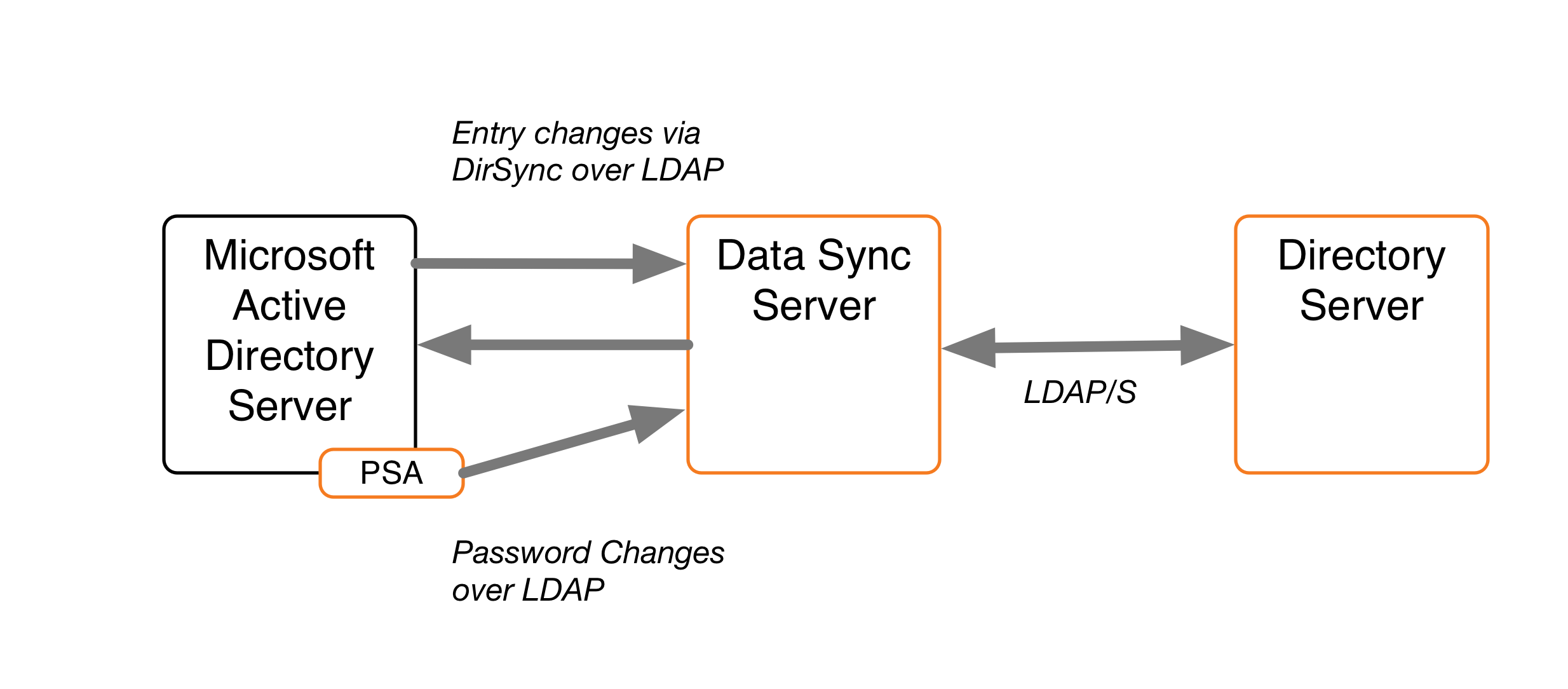Password sync agent
| The Password Sync Agent cannot be pointed at multiple domain clusters. |
| If the Password Sync Agent is down for any length of time and misses a password change, these changes will not be synced on recovery without either a new password change for the entry or the use of pass-through authentication. |
When synchronizing passwords with Active Directory (AD) systems, PingDataSync requires that the Ping Identity Password Sync Agent (PSA) be installed on all domain controllers in the synchronization topology. This component provides real-time outbound password synchronization from Microsoft Active Directory to any supported Sync Destinations.
The PSA component provides password synchronization between directories that support differing password storage schemes. The PSA immediately hashes the password with a 160-bit salted secure hash algorithm and erases the memory where the clear-text password was stored. The component only transmits data over a secure (SSL) connection, and follows Microsoft’s security guidelines when handling clear-text passwords. The PSA also uses Microsoft Windows password filters, which are part of the local security authority (LSA) process. The password filters enable implementing password policy validation and change notification mechanisms. For more information, see Microsoft’s product documentation.
The default password hashing algorithm is SSHA256. To change the algorithm, create a registry key in the Windows registry under HKLM\SOFTWARE\UnboundID\PasswordSync called PASSWORD_HASHING_ALGORITHM. The options are SSHA, SSHA1, SSHA256, SSHA384, and SSHA512.
|
For outbound password synchronization from a PingDirectory server to AD, enable the Password Encryption component. See Configuring password encryption for more information. |

The PSA supports failover between servers. It caches the hashed password changes in a local database until it can be guaranteed that all PingDataSyncs in the topology have received them. The failover features enable any or all of the PingDataSyncs to be taken offline without losing any password changes from Active Directory.
The PSA is safe to leave running on a domain controller indefinitely. To stop synchronizing passwords, remove the userPassword attribute mapping in PingDataSync, or stop the server. The PSA will not allow its local cache of password changes to grow out of control; it automatically cleans out records from its local database as soon as they have been acknowledged. It also purges changes that have been in the database for more than a week.
Before installing the PSA, consider the following:
-
The PSA pre-encodes all passwords with a one-way salted SHA-256 hash before uploading them to PingDataSync. Password changes from Active Directory can only be synchronized to destinations which support setting pre-encoded passwords. Currently, pre-encoded password synchronization is limited to PingDirectory, DSEE, Oracle OUD, and OpenDJ. Active Directory explicitly does not allow for the synchronization of pre-encoded passwords.
-
Syncing a pre-encoded password to PingDirectory skips password validation.
-
Unlike the changelog password encryption plugin, the PSA never has access to a decryptable version of the password, so it cannot sync it to any source that doesn’t support pre-encoded passwords, such as Active Directory.
-
The Active Directory Sync Destination drops any passwords it can’t decrypt without logging anything about the dropped change.
-
Make sure that the Active Directory domain controller has SSL enabled and running.
-
Make sure the PingDataSyncs are configured to accept SSL connections when communicating with the Active Directory host.
-
At least one Active Directory Sync Source (ADSyncSource) needs to be configured on PingDataSync and should point to the domain controller(s) on which the PSA will reside.
-
At the time of installation, all PingDataSyncs in the sync topology must be online and available.
-
The PSA component is for outbound-only password synchronization from the Active Directory Systems. It is not necessary if performing a one-way password synchronization from the PingDirectory Server to the Active Directory server.